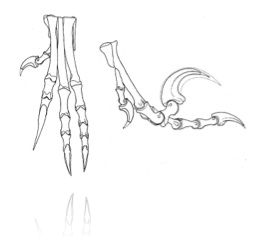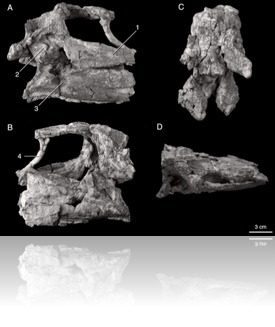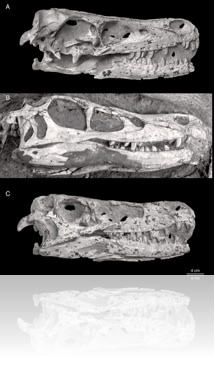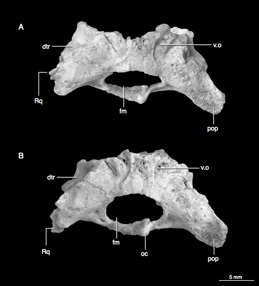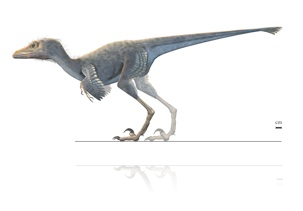October 2013 | |
Goniopholidid Evolution Pritchard, A.C., Turner, A.H., Allen, E.R., and Norell, M.A., 2013. Osteology a North American goniopholipid (Eutretauransosuchus delfsi) and palate evolution in Neosuchia, American Museum Novitates, 3783:1-56 | |
| The goniopholidid Eutretauranosuchus delfsi is currently known from two skulls from the Late Jurassic Morrison Formation of Colorado. Here we present a detailed osteology for a third Eutretauranosuchus delfsi specimen (AMNH FARB 570), consisting of a skull and fragmentary postcranium from Bone Cabin Quarry, Wyoming (Morrison Formation). Addi- tional preparation, computed tomography (CT), and three-dimensional processing of CT images reveal matrix-covered structures on AMNH FARB 570, provide new information on goniopholidid cranial anatomy, and allow for the first description of an articulated North American goniopholidid braincase. These new data, along with restudy of the palatal anatomy in Eutretauranosuchus, provide valuable insight into the phylogenetic history of goniopholi- did crocodyliforms. The skull of AMNH FARB 570 is extremely similar to other specimens of E. delfsi and Amphicotylus spp., especially in details of the architecture of the palate. In these Morrison Formation goniopholidids the secondary palate is incomplete such that the nasopharyngeal passage has no ventral floor. Additionally, there is a complex septum, con- structed from the vomers and pterygoid, which extends ventrally near to the plane of the secondary palate. Characters diagnosing Eutretauranosuchus delfsi include: (1) an elongate, platyrostral skull; (2) a prominent depression on the posterolateral surface of the alveolar process of the maxilla; (3) minimal lateral undulation of the maxillary tooth row; (4) broad-ening of the nasals anterior to the prefrontals; (5) nasals that do not contact external nares; (6) a broad, flat interfenestral bar with raised rims along the supratemporal fenestrae; (7) a nasopharyngeal septum formed from diverging vomeral processes anteriorly and a midline pterygoid process posteriorly (also in Amphicotylus lucasii, AMNH FARB 5782); and (8) a vomeral septal complex that forms an X shape in cross section. Based on a revised phylogenetic analysis of 88 crocodylomorph taxa, a novel phylogenetic hypothesis is proposed in which a clade of Calsoyasuchus + Sunosuchus is sister to a clade of Goniopholis baryglyphaeus + (Goniopholis simus + (Amphicotylus lucasii + Eutretauranosuchus delfsi)). Examination of secondary palate characters in Goniopholididae suggests that this group “experimented” with changes to the bony secondary palate a number of times, resulting in morphologies not seen other mesoeucrocodylian clades. | 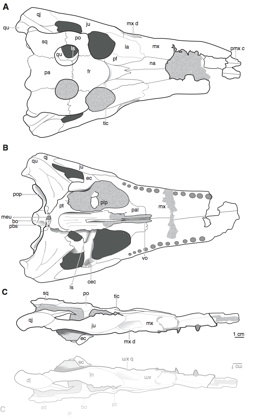 |
April 2013 | |
Archosaur Bodysize Turner, A.H., and Nesbitt, S.J. 2013. Body size evelution during the Triassic archosauriform readition. Geological Society of London, Special Publications | |
| The first large (.1 m) diapsids appeared near the Permian–Triassic extinction and a subset of diapsids, the archosauriforms, expanded their body size range soon after in the Early– Middle Triassic. Here, we examine body size at key evolutionary events within Archosauriformes during the Triassic and through the end-Triassic extinction. Using femoral length as a body size proxy and a temporally calibrated phylogeny of Archosauriformes, we estimate ancestral body sizes using a maximum likelihood approach and test for the presence of an adapative radiation by comparing the fit of competing evolutionary models. Archosauriform body size is characterized by punctuated change with more change occurring early in the Triassic. Archosaurs crossing the Triassic – Jurassic boundary show a wide range in ancestral size, and dinosaurs (sauropodomorphs and theropods) are considerably larger in the Jurassic. Crocodylomorph origins are characterized by a drop in body size; however, both the relative amount of change and the rate of change are matched among other archosaur clades. Archosauriforms increase in absolute body size through the Triassic and evidence suggests that a directional trend in size increase occurred in the early Mesozoic. The morphological signature of adaptive radiation is rare in comparative data from extant animals but is present at the origination of Archosauriformes. | 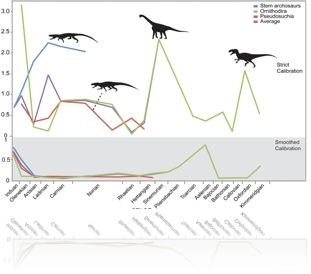 |
February 2013 | |
| Balaur Osteology BRUSATTE, S.L., VRMIR, M., CSIKI-SAVA, Z., TURNER, A.H., WATANABE A., ERICKSON, G.M., AND NORELL., M.A. 2013. The osteology of Balaur Bondoc, and island dwelling dromeaosaurid (Dinosauria: Theropoda) from the late4 Cretaceous of Romania, Bulletin of the American Museum of Natural History 374,1-100 | |
| The Ha ̧teg Island fauna of the terminal Late Cretaceous (ca. 71–65 million years ago) of Romania is one of the most unusual dinosaur assemblages in the global fossil record. It has long been recognized that many herbivorous dinosaurs from the Ha ̧teg fauna were dwarfed, morphologically aberrant, and/or primitive relative to mainland contemporaries, and these taxa are often considered examples of the so-called island effect: the evolutionary phenomenon by which island-dwelling species are often dwarfed and anatomically modified. Very little, however, is known about the carnivorous dinosaurs that inhabited Ha ̧teg Island, and it is unclear whether they were also dwarfed, aberrant, or primitive. In 2009, the discovery of the first substantially complete theropod from the Late Cretaceous of Europe, the holotype of the Romanian dromaeosaurid Balaur bondoc, provided the first clear glimpse at an island-dwelling carnivorous dinosaur. Here we describe and figure this remarkably preserved skeleton in detail. We provide detailed descriptions and photographs of individual bones, and make extensive comparisons with other dromaeosaurids (and other derived coelurosaurian theropods). This monographic description provides further evidence that Balaur is an unusual derived dromaeosaurid, closely related to Velociraptor, with a remarkably modified hand and foot skeleton, including a stocky and heavily fused distal hind limb, a double set of hyperextensible pedal claws, and a fused and atrophied hand, which are otherwise unknown among derived coelurosaurian theropods. We present an updated diagnosis of Balaur based on additional preparation of the holotype, comparisons with other dromaeosaurids, and careful consideration of postmortem crushing. Histological techniques demonstrate that both the holotype and a referred specimen of Balaur, which is approximately 50% larger than the holotype and from a separate locality, belong to mature individuals. Therefore, we remove the referred specimen from Balaur bondoc and conservatively consider it Balaur sp. We present an updated assessment of the phylogenetic relationships of Balaur based on a comprehensive new coelurosaurian cladistic dataset, which corroborates the close relationship between Balaur, Velociraptor, Deinonychus, Adasaurus, and Saurornitholestes. We review the fossil record of European Late Cretaceous theropods and show that other specimens from the Late Cretaceous of Romania (including the holotype of Elopteryx), France, and Hungary either do not belong to Balaur (due to the lack of Balaur autapomorphies) or cannot be compared to Balaur because of a lack of overlapping material. Finally, we discuss the biogeographic history of European terminal Cretaceous dinosaur faunas and comment on the extreme morphological specializations of Balaur. We conclude that the phylogenetic position of Balaur, a derived dromaeosaurid closely related to Late Cretaceous Laurasian taxa, is inconsistent with previous hypotheses of long-term geographic endemicity of the Romanian island faunas, but argue that the aberrant Bauplan of Balaur is similar to that seen in some living and recently extinct mammals and thus likely due to the ‘‘island effect.’’ | 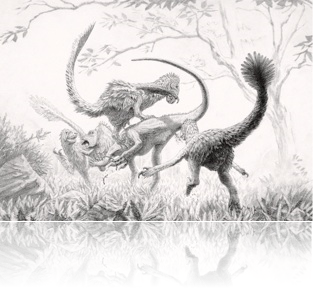 |
| August 2012 | |
Dromaesauridae Systematics Turner, A.H., Makovicky, P.J., and Norell, M.A. 2012. A Review of Dromaeosaurid Systematics and Paravian Phylogeny. Bulletin of the American Museum of Natural History 371, 1-206 | |
| Coelurosauria is the most diverse clade of theropod dinosaurs. Much of this diversity is present in Paraves—the clade of dinosaurs containing dromaeosaurids, troodontids, and avialans. Paraves has over 160 million years of evolutionary history that continues to the present day. The clade represents the most diverse living tetrapod group (there are over 9000 extant species of Aves—a word used here as synonomous with ‘‘bird’’), and it is at the root of the paravian radiation, when dromaeosaurids, troodontids, and avialans were diverging from one another, that we find the morphology and soft tissue changes associated with the origin of modern avian flight. Within the first 15 million years of known paravian evolutionary history members of this clade exhibited a difference of nearly four orders of magnitude in body size, a value that is similar to the extreme body size disparity present today in mammalian carnivorans, avians, and varanoid squamates. In this respect, Paraves is an important case study in characterizing the patterns, processes, and dynamics of evolutionary size change. This last point is of particular interest because of the historical significance placed on the role of body size reduction in the origin of powered avian flight. Our study reviews and revises the membership of Dromaeosauridae and provides an apomorphy-based diagnosis for all valid taxa. Of the currently 31 named dromaeosaurid species, we found 26 to be valid. We provide the most detailed and comprehensive phylogenetic analysis of paravians to date in order to explore the phylogenetic history of dromaeosaurid taxa. The general pattern of paravian relationships is explored within the broader context of Coelurosauria with an emphasis on sampling basal avialans, because of their importance for character optimizations at the base of Paraves. A large dataset was constructed by merging two datasets, one examining coelurosaur relationships broadly (based on previous TWiG datasets) and the other examining avialan relationships specifically (Clarke et al., 2006). This merged dataset was then significantly revised and supplemented with novel character analysis focusing on paravian taxa. During character analysis, particular attention was given to basal members of Dromaeosauridae, enigmatic basal paravians such as Jinfengopteryx elegans and Anchiornis huxleyi, and the incorporation of new morphological information from two undescribed troodontid species from the Late Cretaceous of Mongolia. A final dataset of 474 characters scored for 111 taxa was used to address paravian evolution. This dataset is important in that it bridges a phylogenetic gap that had persisted between studies on birds and studies on all other coelurosaurs. Most scorings in this matrix were based on the direct observation of specimens. All most parsimonious trees recovered in the cladistic analysis support the monophyly of Paraves, Troodontidae, Dromaeosauridae, and Deinonychosauria. A new clade of basal troodontids is discovered including two undescribed Mongolian troodontids and Jinfengopteryx elegans. Xiaotingia and Anchiornis form a clade at the base of Troodontidae. Recently proposed relationships within Dromaeosauridae are further supported and a succession of clades from Gondwana and Asia form sister taxa to a clade of Laurasian dromaeosaurids. Avialan monophyly is strongly supported with Archaeopteryx, Sapeornis, Jeholornis, and Jixiangornis forming the successive sister taxa to the Confuciusornis node. This topology supports a more basal position for Sapeornis than previous phylogenetic analyses and indicates a progressive acquisition of a fully ‘‘avian’’ shoulder morphology. |
|
November 2011 | |
Mahalak omnogovae Turner, A.H., Pol, D., and Nornell, M.A. 2011. Anatomy of Mahalak omnogovae (Theropada: Dromaeosauridae), Togroglin Shiree, Mongolia. American Museum of Novitates 3722, 1-66 | |
| The dromaeosaurid Mahakala omnogovae is known from a unique specimen from the Late Cretaceous deposits of the Djadokhta Formation at Tögrögiin Shiree, Ömnögov Aimag, Mongolia. The holotype specimen is comprised of a well-preserved but partial skull and a nearly complete postcranial skeleton. Mahakala omnogovae is included in a comprehensive phylogenetic analysis of Coelurosauria using a dataset, which reflects a greatly expanded character set and taxon-sampling regime. Several interesting features of Mahakala omnogovae have implications for deinonychosaurian and avialan character evolution and for understanding patterns of size variation and size change within paravian theropods. These morphologies include the shape of the iliac blade, the triangular obturator process of the ischium, and the evolution of the subarctometatarsalian condition. We present an expanded diagnosis of Mahakala omnogovae, which included following unique combination of characters (autapomorphies noted by *): a ledgelike depression at the confluence of metotic strut and posterior tympanic recess on the anterior face of the paroccipital process*, a posteriorly tapering scapula; a shortened forelimb (humerus 50% femur length); a strongly compressed and anteroposteriorly broad ulna tapering posteriorly to a narrow edge*; elongate lateral crest on the posterodistal femur*; anterior caudal vertebrae with subhorizontal, laterally directed prezygapophyses*; a prominent supratrochan- teric process; and the absence of a cuppedicus fossa. |
|
February 2011 | |
| Albinykus Baatar Nesbit, S.J., Clarke, J.A., Turner, A.H., and Norell, M.A. 2011. A small alvarzaurid from the eastern Gobi Deser offers insite into evolutionary patterns in the Alvarezauroidea. Journal of Vertebrate Paleontology 31, 144-153 | |
A partial postcranial skeleton of a small alvarezsaurid from the Late Cretaceous of the Mongolian eastern Gobi Desert locality of Khugenetslavkant represents the first reported articulated theropod material from that locality. The specimen is recognized as the holotype of a new taxon named Albinykus baatar, gen. et sp. nov. Phylogenetic analysis places Albinykus within Alvarezsauridae as the sister taxon of Shuvuuia, another Late Cretaceous Mongolian taxon from the slightly younger Djadokhta Formation. The complete coossification of the proximal tarsals with the tibia, and of the distal tarsals and proximal metatarsals, present in Albinykus are previously unknown in Alvarezsauridae. Extensive fusion is consistent with histological data from the tibia indicating that the individual was a subadult. These results are striking given that Albinykus is among the smallest known non-avian dinosaurs with a body mass no greater than 1 kg and ranks among the smallest known alvarezsaurids. Alvarezsauridae shows a decreasing size trend throughout its evolutionary history, a rarity among dinosaurian clades. Within maniraptoran dinosaurs, such a trend has thus far only been recognized within Avialae and at the origin of Paraves with respect to other coelurosaurs. The holotype was recovered articulated in a ‘seated’ position, with hind limbs aligned and the feet tucked under the body. This body posture, which is present in Aves, has been previously noted in other maniraptoran clades (i.e., Oviraptoridae Troodontidae) and is now recognized in Alvarezsauridae. | 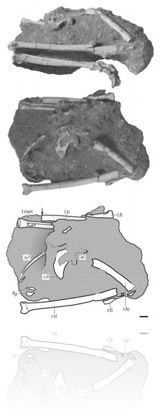 |
November 2010 | |
Simosuchus Clarki -- SVP Kley, N.J., Seritich, J.J.W., Turner, A.H., Krause, D.W., O'Connor, P.M., and Georgi, J.A., 2010. Turner., A.H. and Sertich, J.J.W. 2010. Phylogenetic hisotry of Simosuchus clarki | |
| Simosuchus clarki is an amazing looking pug-nosed crocodyliform first described in 2000 on the basis of a single specimen (Buckley et al., 2000). Now it is now from multiple well preserved specimens and is arguably the most completely known and best preserved of all of the notosuchian crocodyliforms. The 10th Memoir of the Society of Vertebrate Paleontology is a combined effort of 8 researchers that provides a detailed description of its anatomy and inferences of its place in nature—how it moved, what it ate, its environment, its closest relatives, and when and where they lived. The introductory chapter (Krause et al.) details the history of the discovery of S. clarki, lists the inventory of currently known specimens, and provides the con- text of when and where it once lived. Kley et al. provides a detailed description of the craniofacial and dental anatomy of S. clarki, as revealed by the exquisitely preserved skull and lower jaw of the holotype and with the assistance of high- resolution CT scans. Georgi and Krause provide a description of the postcranial axial skeleton and a description of the appendicular skeleton is provided by Sertich and Groenke. Owing to the excellent preservation of osteoderms on several specimens, and their complex distributional pattern, the integumentary system is given separate treatment by Rob Hill. Each of the descriptive chapters also includes analyses of the functional morphology of the skeletal region in question. Furthermore, the excellent preservation and relatively complete knowledge of the osteology of S. clarki provide the opportunity to comprehensively reassess notosuchian relationships (Turner and Sertich) who also employ that knowledge to reassess the biogeographic history of notosuchians. | 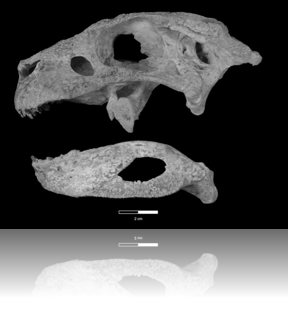 |
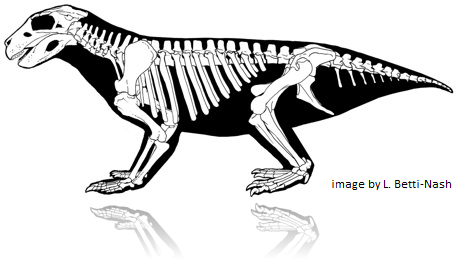 | |
Simosuchus clarki FAQ
| |
Press Release Stony Brook University Society of Vertebrate Paleontology Popular Coverage BBC News ScienceDaily USA Today |


